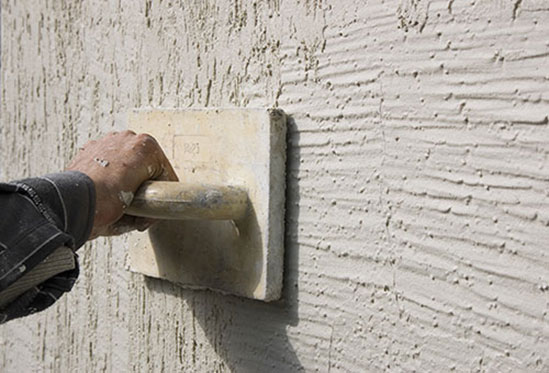How to Repair Cracks in Stucco and When to Fix Them

Are you wondering when to repair cracks in stucco? Stucco is pretty durable, but with them, cracks are a way of life. Most of the cracks are not serious and do not cause any structural damage. With these cracks showing up now and then, homeowners always question when they should repair stucco cracks.
The answer is: immediately. You need to repair the stucco cracks as soon as possible every time you see one. While the crack isn’t the problem in itself, moisture seepage through the crack is an issue that can later lead to mold and dampness, resulting in serious health issues.
While hairline stucco cracks seem small, they can spread further and create issues after a while. If you handle them now with a simple caulk, you are arresting the further spread of the crack.
Why does stucco crack?
Your stucco cracking can happen due to any number of reasons:
- Seismic events
- Wrong proportion
- Inadequate mixing
- Poor quality
- Shrinkage induced stress
While the last option occurs during the drying period, the rest can happen at any time.
How Serious are the Stucco Cracks?
Most of the cracks in stucco aren’t serious, like hairline cracks. However, the issue comes when these lay paths for moisture to seep inside. Once water gets into the wall, it will cause untold damage to the structure.
The seeping water softens the stucco from inside, causing it to break away from the structure. Peeing paints, wood rot, mold, swollen drywall, etc., are some of the problems you would have to face down the line.
Unlike hairline cracks, deeper and larger cracks are a thing of concern and should be dealt with at once. The more severe cracks are those whose edges have moved and not in relation to the other end. This means foundational damage, which you might want to attend to first.
What Are the Different Types of Stucco Cracks?
Though all the cracks look similar when it comes to stucco, there are quite a few different varieties. Each of them occurs due to various factors and hence should be handled accordingly.
Here are the different cracks you will find in your stucco.
- Hairline Cracks: They are the most common of the cracks and are usually harmless. Usually thin, these cracks happen when the plaster settles and also due to the construction work.
- Spider Cracking: If spiderweb-like cracks appear in your stucco, it is because your base coat did not cure properly. It may also be due to a wet mix or improper temperature setting.
- Diagonal Cracking: As the name indicates, these cracks are seen around windows and doors diagonally in nature. They happen due to shifting foundations and seismic changes in the foundations. You may want to investigate and attend to these cracks first.
- Foam Trim Cracks: Foam trim cracks indicate that your contractor did not use fiberglass mesh tape when constructing the foam trim on the stucco. This can lead to breakage over time.
- Pattern Cracking: If the cracking follows a distinct pattern (horizontal and vertical lines), then the lath is the issue. When it is not installed correctly, you may see this type of crack.
Stucco Cracks: When to Worry
Identifying when to take action on stucco cracks is crucial for maintaining the integrity and appearance of your home’s exterior. Not all stucco cracks pose a threat, but there are certain signs that indicate a need for immediate attention:
- Width and Depth: Hairline cracks are common and often not a concern. However, cracks wider than 1/16 inch may allow moisture to penetrate, leading to more significant issues.
- Location and Pattern: Cracks around windows, doors, and at the corners of buildings can indicate structural movement or settling. Diagonal or stair-step cracks, particularly those that change direction sharply, should be inspected.
- Length: Long, continuous cracks or multiple cracks in a specific area can signify underlying problems that need to be addressed to prevent further damage.
- Changes Over Time: Cracks that widen, deepen, or multiply over time suggest ongoing issues that warrant professional evaluation.
How to Fix Hairline Cracks in Stucco
Repairing hairline cracks in stucco is a manageable task for homeowners looking to maintain their property’s aesthetic and structural integrity. Here’s a step-by-step guide to fixing these minor imperfections:
- Clean the Crack: Use a brush or vacuum to remove dust, debris, and loose stucco from the crack and its surrounding area to ensure a clean surface for repair.
- Apply a Crack Sealant: Choose a high-quality, flexible, paintable sealant designed for stucco repair. For hairline cracks, a caulk gun can be used to inject the sealant directly into the crack, filling it completely.
- Smooth the Sealant: Use a putty knife or your finger (wearing a glove) to smooth the sealant and ensure it’s fully pressed into the crack. Wipe away any excess sealant from the surface of the stucco to leave a clean finish.
- Allow to Dry: Follow the manufacturer’s instructions for drying or curing time. The sealant needs to dry completely before any further steps, such as painting, are taken.
- Paint (if necessary): If the repair area stands out from the rest of the wall, consider applying a coat of paint that matches the existing stucco color. Use a paint that’s suitable for exterior stucco surfaces to ensure a uniform appearance.
By addressing hairline cracks promptly, you can prevent them from evolving into more serious problems, keeping your stucco surfaces looking great and performing well over time.
Repair Stucco Cracks FAQs
How long should stucco last before cracking?
Hairline cracks are always expected with stucco; they appear on a newly applied stucco after a couple of weeks. But excessive shrinkage cracking is not acceptable, and covering them with finish coating doesn’t work for a long time. A properly applied stucco can last as long as 50 years before needing any repair job.
What is the cost to repair stucco cracks?
The stucco crack repair cost depends on the time taken and also the complexity of the issue at hand. The contractors also wait between each layer for the curing process to complete, which accounts for the price.
Should you power wash stucco?
Stucco is an excellent alternative to the run-of-the-mill brick and stone walls. But its textured surface is notorious for attracting dust over a long period. However, a power wash should help you get rid of the accumulated dirt and stains.
Call Wild West Painting When Its Time To Repair Cracks in Stucco Walls
Stucco walls are beautiful to look at. However, they are prone to cracks caused by shrinkage (hairline cracks) and other installation problems. They do not cause as much a problem at first but can lead to water damage if left unchecked.
With minor hairline cracks, you can fill them yourself and arrest the spread. But for more extensive damages like diagonal cracks, you might want to consult an expert in this matter. In short, any issues with the stucco should be handled with an urgency to help preserve the beauty.
At Wild West Painting, we have been providing professional residential and commercial painting and stucco repairs for over 25 years! Our painters provide Commercial and House painting services in Tucson, which includes Green Valley, Marana, Oro Valley, Sahuarita, and Vail. If you or someone you know would like help painting and/or repairing the stucco on your house or office building, please contact us for your free quote today.






